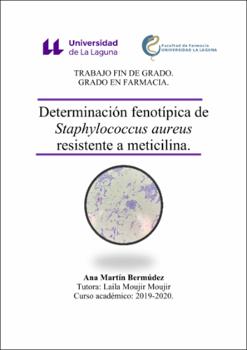Determinación fenotípica de Staphylococcus aureus resistente a meticilina.
Author
Martín Bermudez, AnaDate
2020Abstract
Staphylococcus aureus is a type of bacteria that causes a wide variety of infections
in humans. The main reservoir is the human being, found in healthy carriers, especially
in the nostrils, as well as in infected patients. Colonization can settle on the nasal mucosa,
oropharynx, entire epidermis, chronic skin ulcers, wounds in the healing phase or in the
urethra of indwelling catheter.
Its main impact is due to the methicillin resistant strains (MRSA) that show
resistance to all beta-lactams (penicillins, cephalosporins, carbapenems and
monobactams), and other antibiotics, which makes their treatment difficult. These strains
were limited to the hospital environment (MRSA-HA), being responsible for the majority
of nosocomial bacteremia. However, since the 1990s its epidemiology has changed until
it appears more and more in the community environment (MRSA-CO). Community
strains can infect healthy individuals and present some toxins such as Panton-Valentine
leukocidin (PVL) and phenol-soluble modulin (PSM) peptide toxins that give them
greater virulence than SARM-HA. That is why the rapid detection of the nasal carrier
state contributes to adequate control and treatment in order to reduce its transmission.
The objective of this work is to determine the prevalence of CO-MRSA. For this,
65 samples were collected from the nostrils of volunteers from the community
environment, for subsequent identification by biochemical tests and phenotypic
determination of methicillin. Staphylococcus aureus es una bacteria que causa una gran variedad de infecciones
en humanos. El principal reservorio es el hombre, hallándose en los portadores sanos,
especialmente en las fosas nasales, así como en los pacientes infectados. La colonización
puede asentar sobre la mucosa nasal, orofaringe, epidermis íntegra, úlceras crónicas
cutáneas, heridas en fase de cicatrización o en la uretra de portadores de sonda.
Su principal impacto es debido a las cepas resistentes a la meticilina (SARM) que
presentan resistencia a todos los betalactámicos (penicilinas, cefalosporinas,
carbapenemas y monobactamas) y a otros antibióticos, lo que dificulta su tratamiento.
Estas cepas se limitaban al ambiente hospitalario (SARM-HA) siendo responsable de la
mayoría de las bacteriemias nosocomiales. Sin embargo, desde la década de los noventa
su epidemiología ha cambiado hasta aparecer cada vez más en el ambiente comunitario
(SARM-CO). Las cepas comunitarias pueden infectar a individuos sanos y presentan
algunas toxinas como son la leucocidina Panton-Valentine (PVL) y las toxinas peptídicas
de la modulina soluble en fenol (PSM) que las dotan de mayor virulencia que SARMHA. Por ello, la rápida detección del estado de portador es fundamental en el control y
tratamiento con el fin de reducir la transmisión.
El objetivo de este trabajo es determinar la prevalencia de SARM-CO. Para ello,
se recolectaron 65 muestras de las fosas nasales de voluntarios del ambiente comunitario,
para su posterior identificación mediante pruebas bioquímicas y la determinación
fenotípica de la resistencia a meticilina.





